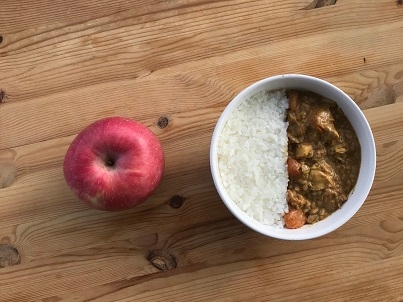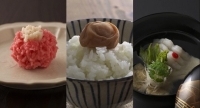Japanese Kitchen
2021/5/11
This month we travel to Aomori, the northernmost prefecture of Honshu (the main island of Japan) in the Tohoku region. Almost half of the prefecture's residents live in its two core cities, Aomori and Hachinohe and the majority of the prefecture is covered in forested mountain ranges. The Tsugaru region of Aomori is where the instrument Tsugaru-jamisen comes from, and the region is also known for its unique lacquerware style, Tsugaru-nuri. Find out more about the prefecture in the article below!
Apple Curry Rice
 Aomori Nebuta Festival ©JNTO
Aomori Nebuta Festival ©JNTO
 Inakadate rice fields ©JNTO
Inakadate rice fields ©JNTO
by Mark McEvoy
Japan Information and Cultural Centre
Aomori is the second-most northern prefecture in Japan and is home to some spectacular sights. The Aomori Nebuta Festival is an annual festival held at the start of August and features a parade of gigantic floats measuring up to 7m long. The floats are inspired by Japanese folklore, regional myths and local personalities.
Every summer, the inhabitants of Inakadate use rice fields as canvas to produce large pictures as a way to revitalize their village and honour the agricultural past of the area. The artworks are created using varieties of rice crops in an array of colours. Viewing platforms are erected to accommodate visitors and a different theme is announced every year.
But Aomori’s most famous export is perhaps the apple. The cooler summers there are perfect for growing apples which is why Aomori produces more than half of the apples grown in the country. One of its most famous varieties is the Fuji apple which is known for its crisp texture and sweetness. They take their name from the town of Fujisaki where researchers created a hybrid cross between the Red Delicious and Virginia Ralls Janet in the late 1930s.
It is the apple which I have chosen to focus on for my contribution to this series. When I was growing up, my family didn’t eat curry at all because my parents considered it too spicy a dish for children to eat. So it was as a student in Japan that I quickly realised why their version of curry was universally popular … it was the sweetness that made it appealing. Japanese curry seemed to provide numerous possibilities as it goes well with udon noodles, pork cutlets and bread but I was also intrigued by the regional variations of the dish and I made sure to seek new versions when travelling throughout the country.
Fuji apples can be found in Asian supermarkets but if not, Gala apples are a perfectly acceptable substitute for this dish. Although blocks of Japanese curry roux can be found in shops across the UK, this ‘made from scratch’ recipe is a lot easier to make than it seems.
Japan Information and Cultural Centre
Aomori is the second-most northern prefecture in Japan and is home to some spectacular sights. The Aomori Nebuta Festival is an annual festival held at the start of August and features a parade of gigantic floats measuring up to 7m long. The floats are inspired by Japanese folklore, regional myths and local personalities.
Every summer, the inhabitants of Inakadate use rice fields as canvas to produce large pictures as a way to revitalize their village and honour the agricultural past of the area. The artworks are created using varieties of rice crops in an array of colours. Viewing platforms are erected to accommodate visitors and a different theme is announced every year.
But Aomori’s most famous export is perhaps the apple. The cooler summers there are perfect for growing apples which is why Aomori produces more than half of the apples grown in the country. One of its most famous varieties is the Fuji apple which is known for its crisp texture and sweetness. They take their name from the town of Fujisaki where researchers created a hybrid cross between the Red Delicious and Virginia Ralls Janet in the late 1930s.
It is the apple which I have chosen to focus on for my contribution to this series. When I was growing up, my family didn’t eat curry at all because my parents considered it too spicy a dish for children to eat. So it was as a student in Japan that I quickly realised why their version of curry was universally popular … it was the sweetness that made it appealing. Japanese curry seemed to provide numerous possibilities as it goes well with udon noodles, pork cutlets and bread but I was also intrigued by the regional variations of the dish and I made sure to seek new versions when travelling throughout the country.
Fuji apples can be found in Asian supermarkets but if not, Gala apples are a perfectly acceptable substitute for this dish. Although blocks of Japanese curry roux can be found in shops across the UK, this ‘made from scratch’ recipe is a lot easier to make than it seems.
Apple curry recipe
Ingredients (serves 2)
Roux:
Instructions

- 2 tbsp vegetable oil
- 2 boneless and skinless chicken thighs, diced into bitesize pieces
- 2 white onions, sliced lengthwise
- 1 apple (Fuji or Gala), peeled, cored and diced
- 2 carrots, peeled and roughly chopped
- 125ml chicken or vegetable stock
- 2 tbsp honey
- 3 bay leaves
Roux:
- 1 tbsp ground coriander
- 1 tbsp cumin
- 1 tbsp turmeric
- 1 tbsp garam masala
- 1 tsp ground black pepper
- 1 tsp cayenne pepper
- 40g butter
- 40g flour
Instructions

- Add the vegetable oil to a pan and cook the chicken pieces until browned all over.
- Remove the chicken and set aside.
- In the same pan, add the onions and cook until translucent.
- Place the cooked chicken back in the pan and add the apple, carrots and stock and cook over a high heat until the carrots become soft. While this is cooking, prepare the roux.
- In a different pan, dissolve the butter over a low heat and stir in the flour.
- Separately, dry roast the spices over a low heat to release the aromatic flavours. Add these spices to the roux and mix well.
- Add the curry roux to the chicken mixture and stir until it starts to thicken.>
- Add in the honey and bay leaves and simmer on a low heat for 15 minutes.
- The thickness of the sauce can be adjusted by adding water to thin out the mixture or leaving it to simmer longer to make it thicker.

